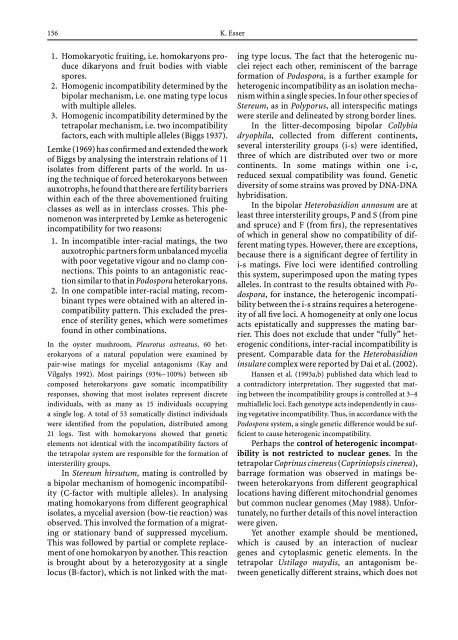Growth, Differentiation and Sexuality
Growth, Differentiation and Sexuality
Growth, Differentiation and Sexuality
You also want an ePaper? Increase the reach of your titles
YUMPU automatically turns print PDFs into web optimized ePapers that Google loves.
156 K. Esser<br />
1. Homokaryotic fruiting, i.e. homokaryons produce<br />
dikaryons <strong>and</strong> fruit bodies with viable<br />
spores.<br />
2. Homogenic incompatibility determined by the<br />
bipolar mechanism, i.e. one mating type locus<br />
with multiple alleles.<br />
3. Homogenic incompatibility determined by the<br />
tetrapolar mechanism, i.e. two incompatibility<br />
factors, each with multiple alleles (Biggs 1937).<br />
Lemke (1969) has confirmed <strong>and</strong> extended the work<br />
of Biggs by analysing the interstrain relations of 11<br />
isolates from different parts of the world. In using<br />
the technique of forced heterokaryons between<br />
auxotrophs, he found that there are fertility barriers<br />
within each of the three abovementioned fruiting<br />
classes as well as in interclass crosses. This phenomenon<br />
was interpreted by Lemke as heterogenic<br />
incompatibility for two reasons:<br />
1. In incompatible inter-racial matings, the two<br />
auxotrophic partners form unbalanced mycelia<br />
with poor vegetative vigour <strong>and</strong> no clamp connections.<br />
This points to an antagonistic reactionsimilartothatinPodospora<br />
heterokaryons.<br />
2. In one compatible inter-racial mating, recombinant<br />
types were obtained with an altered incompatibility<br />
pattern. This excluded the presence<br />
of sterility genes, which were sometimes<br />
found in other combinations.<br />
In the oyster mushroom, Pleurotus ostreatus, 60 heterokaryons<br />
of a natural population were examined by<br />
pair-wise matings for mycelial antagonisms (Kay <strong>and</strong><br />
Vilgalys 1992). Most pairings (93%–100%) between sib<br />
composed heterokaryons gave somatic incompatibility<br />
responses, showing that most isolates represent discrete<br />
individuals, with as many as 15 individuals occupying<br />
a single log. A total of 53 somatically distinct individuals<br />
were identified from the population, distributed among<br />
21 logs. Test with homokaryons showed that genetic<br />
elements not identical with the incompatibility factors of<br />
the tetrapolar system are responsible for the formation of<br />
intersterility groups.<br />
In Stereum hirsutum, matingiscontrolledby<br />
a bipolar mechanism of homogenic incompatibility<br />
(C-factor with multiple alleles). In analysing<br />
mating homokaryons from different geographical<br />
isolates, a mycelial aversion (bow-tie reaction) was<br />
observed. This involved the formation of a migrating<br />
or stationary b<strong>and</strong> of suppressed mycelium.<br />
This was followed by partial or complete replacement<br />
of one homokaryon by another. This reaction<br />
is brought about by a heterozygosity at a single<br />
locus(B-factor),whichisnotlinkedwiththemat-<br />
ing type locus. The fact that the heterogenic nuclei<br />
reject each other, reminiscent of the barrage<br />
formation of Podospora, isafurtherexamplefor<br />
heterogenic incompatibility as an isolation mechanism<br />
within a single species. In four other species of<br />
Stereum, asinPolyporus, all interspecific matings<br />
were sterile <strong>and</strong> delineated by strong border lines.<br />
In the litter-decomposing bipolar Collybia<br />
dryophila, collected from different continents,<br />
several intersterility groups (i-s) were identified,<br />
three of which are distributed over two or more<br />
continents. In some matings within one i-c,<br />
reduced sexual compatibility was found. Genetic<br />
diversity of some strains was proved by DNA-DNA<br />
hybridisation.<br />
In the bipolar Heterobasidion annosum are at<br />
least three intersterility groups, P <strong>and</strong> S (from pine<br />
<strong>and</strong> spruce) <strong>and</strong> F (from firs), the representatives<br />
of which in general show no compatibility of different<br />
mating types. However, there are exceptions,<br />
because there is a significant degree of fertility in<br />
i-s matings. Five loci were identified controlling<br />
this system, superimposed upon the mating types<br />
alleles. In contrast to the results obtained with Podospora,<br />
for instance, the heterogenic incompatibility<br />
between the i-s strains requires a heterogeneity<br />
of all five loci. A homogeneity at only one locus<br />
acts epistatically <strong>and</strong> suppresses the mating barrier.<br />
This does not exclude that under “fully” heterogenic<br />
conditions, inter-racial incompatibility is<br />
present. Comparable data for the Heterobasidion<br />
insulare complex were reported by Dai et al. (2002).<br />
Hansen et al. (1993a,b) published data which lead to<br />
a contradictory interpretation. They suggested that mating<br />
between the incompatibility groups is controlled at 3–4<br />
multiallelic loci. Each genotype acts independently in causing<br />
vegetative incompatibility. Thus, in accordance with the<br />
Podospora system, a single genetic difference would be sufficient<br />
to cause heterogenic incompatibility.<br />
Perhaps the control of heterogenic incompatibility<br />
is not restricted to nuclear genes. Inthe<br />
tetrapolar Coprinus cinereus (Copriniopsis cinerea),<br />
barrage formation was observed in matings between<br />
heterokaryons from different geographical<br />
locations having different mitochondrial genomes<br />
but common nuclear genomes (May 1988). Unfortunately,<br />
no further details of this novel interaction<br />
were given.<br />
Yet another example should be mentioned,<br />
which is caused by an interaction of nuclear<br />
genes <strong>and</strong> cytoplasmic genetic elements. In the<br />
tetrapolar Ustilago maydis, an antagonism between<br />
genetically different strains, which does not

















